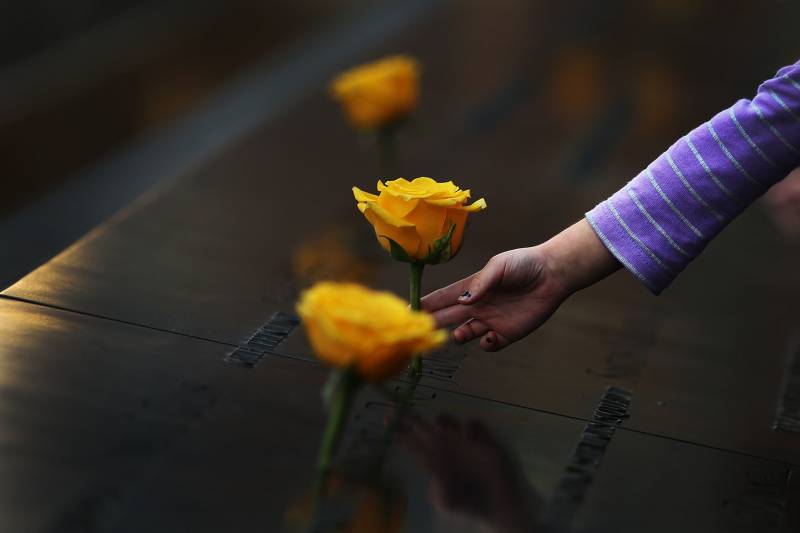For children in grades three to five, Morningside recommends a brief, fact-based account of the day, including that nearly 3,000 people were killed:
"Explain that on September 11, 2001, a group of men took over two planes and flew them into the World Trade Center, a pair of skyscrapers in downtown Manhattan. After several enormous explosions, both buildings collapsed, killing almost 3,000 people. On that same day, two additional planes were hijacked by the same group. One was flown into the Pentagon in Washington, D.C., killing 125 people, while the other crashed in a field in Pennsylvania killing all on board. Though it was never proven, that last plane was thought to be on its way to the White House or the Capitol."
Make room for discomfort
Graves says the scale of pain and loss can understandably unsettle some young students. "They're not used to that," he says. "They're used to stories geared toward kids, and so there's a happy ending."
Other educators note that, especially with older children, we often underestimate what they already know and what they can handle.
"We advise teachers to be bold, and be courageous in meeting the kids where they're at," says Tala Manassah, deputy executive director of the Morningside Center for Teaching Social Responsibility. "Sometimes the edges of our learning happen when we are uncomfortable."
This extends to how educators answer two very hard questions kids have always asked:
Be clear who the attackers were — and weren't
Emily Gardner, an elementary school librarian in Texas, says it's important to be clear and specific when talking about the group of 19 men behind the attacks.
"We're very careful to answer that question, that it's al-Qaida, it's a terrorist organization," Gardner says. "It's not Muslims. It's not people from a certain country."
In some classrooms, the discrimination and Islamophobia that followed the attacks feature prominently in how teachers talk about the lessons of 9/11.
As for answering children when they ask why those 19 men did what they did, Graves says, "I think it is so important for educators, adults to be able to sit with a child and say, 'I don't know.' "
Stress how they can get still help
Graves worked with the group, Global Game Changers, to develop lessons around 9/11. Jan Helson, the group's co-founder, says it's important to follow that "I don't know" with, "But what we do know is that really good people stood up to help us overcome those bad things."
That's why many of the school materials created by the National September 11 Memorial & Museum feature the stories of first responders who ran toward danger that day. It's also important for kids to look not just for those helpers but to feel like they, too, can help.
"We give students an opportunity to respond and take action," says Gardner, who remembers when her school's art teacher "worked with our students and talked about art as empathy. And so our students made paper flowers that we mailed to the memorial."
The Sept. 11 memorial itself suggests several activities that can help kids feel helpful, including making a first responder badge or survivor tree leaves.
Be prepared to share your feelings
Megan Jones, vice president of education at the museum, says one thing has stood out to her this year about the questions she and her staff have been hearing from kids.
In the past, children's curiosity has largely focused on the facts of that day. This year, though, "They're asking, 'What was it like for you? How did you feel after 9/11? When did you feel safe again?' "
The reason for these questions this year, Jones says, is that today's students are living through a new tragedy, one that has upended their lives and killed 650,000 grandparents and parents, brothers and sisters in the U.S. alone. Many children are feeling exhausted and frightened by the pandemic and may be grieving.
Jones says she hopes this COVID-19 generation of students finds solace — and reassurance — in the September 11 Memorial & Museum's annual webinar for schools, which premieres Friday. More than 1 million people, most of them students, have already registered — nearly a threefold increase from last year.
This year, the webinar includes the voice of Brielle Saracini, who was just 10 years old on 9/11. Her father, Victor Saracini, was piloting United Airlines Flight 175 when it was hijacked and flown into the south tower of the World Trade Center.
"I just wanted to be normal," Brielle Saracini says in a prerecorded video, remembering the days immediately after 9/11. "And I kind of internalized a lot of my grief. And grieving in public is very difficult, and so my way of dealing with it was just to kind of be quiet about it."
Ultimately, Saracini found joy, friendship and even her future husband at Camp Better Days, a camp for children who lost loved ones in the attacks. She has also persevered through a personal battle with cancer. Jones says Saracini's story is one of resilience that will resonate with today's COVID-19 generation.
"Young people are looking to a generation who did live through a world-changing event," Jones says, "and they want to know that it's possible to come out of it and how did we do it."



9(MDAxOTAwOTE4MDEyMTkxMDAzNjczZDljZA004))